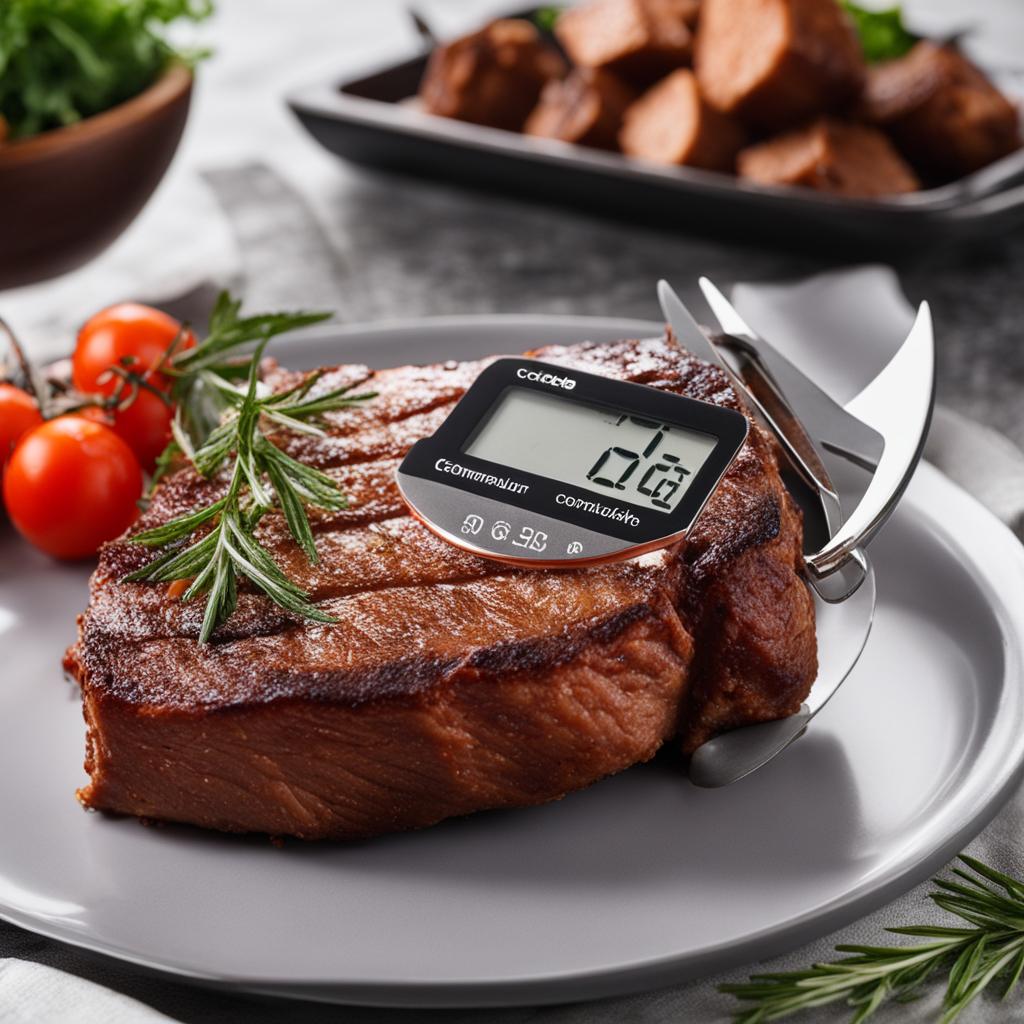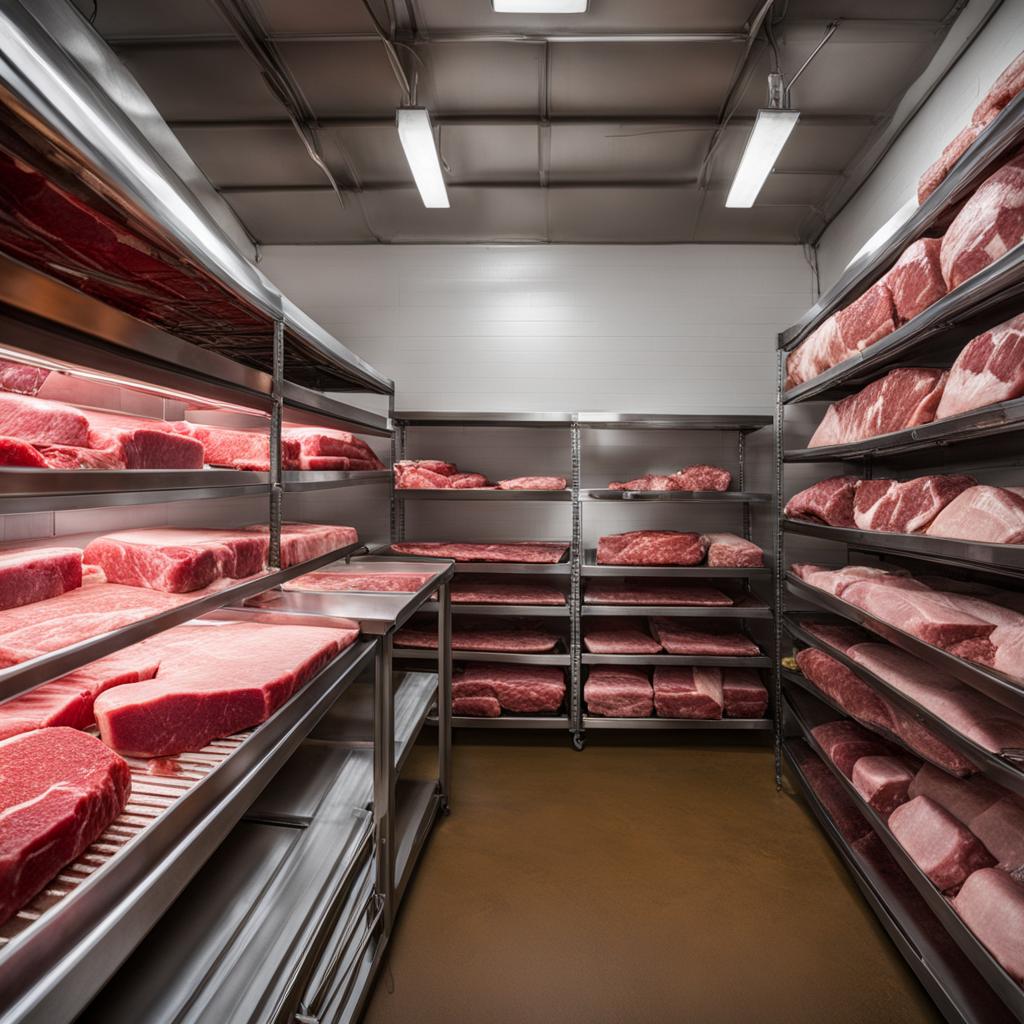To ensure the meat you’re cooking or serving is fresh and safe, it’s important to know how to determine if it has gone bad. Several signs can indicate spoilage, such as an expiration date, changes in color, texture, odor, and taste. By paying attention to these cues, you can prevent food poisoning and ensure that your meals are always delicious.
Key Takeaways:
- Checking the expiration date and shelf life of meat is the first step in determining if it is bad.
- A foul odor is a clear indication that meat has gone bad.
- Color changes in meat can be a sign of spoilage, but not all color changes mean the meat is bad.
- Assessing the texture of meat can help identify spoilage, such as a slimy coating.
- Poultry and seafood can also spoil, so it’s important to be aware of the signs.
Checking Expiration Date and Shelf Life
In order to ensure the freshness of meat, it is crucial to check its expiration date and understand its shelf life. By doing so, you can avoid the risks of consuming spoiled or unsafe meat that may lead to food poisoning. Here are some important factors to consider:
Expiration Date:
Start by checking the expiration date on the packaging of the meat. This date indicates the last day the meat is considered safe to consume. If the meat has passed its expiration date, it is best to discard it to prevent any potential health issues. Remember, consuming expired meat can increase the risk of foodborne illnesses.
Shelf Life of Raw and Cooked Meat:
Understanding the shelf life of meat is essential to ensure its freshness. Raw meat, such as red meat, typically has a shelf life of 1-3 days when refrigerated. Once cooked, red meat can last for 7-10 days in the refrigerator. Ground meat, like minced beef, can be stored for 1-2 days past its sell-by date. On the other hand, chopped meats, steaks, and roasts have a slightly longer shelf life of 3-5 days. However, it is important to note that these time frames are approximate and can vary depending on various factors such as storage conditions and quality of the meat.
By checking the expiration date and understanding the shelf life of different types of meats, you can make informed decisions on whether the meat is safe to consume or should be discarded. Prioritizing food safety is crucial to ensure the health and well-being of yourself and your loved ones.
| Meat Type | Shelf Life (Raw) | Shelf Life (Cooked) |
|---|---|---|
| Red Meat | 1-3 days | 7-10 days |
| Ground Meat | 1-2 days past sell-by date | N/A |
| Chopped Meats, Steaks, and Roasts | N/A | 3-5 days |
Detecting Foul Odor
When it comes to determining if meat has gone bad, detecting a foul odor is one of the key indicators. A bad odor is a clear sign that the meat has spoiled and should not be consumed. The smell can be described as pungent and unpleasant, often resembling the scent of ammonia. If you come across this distinct odor, especially if the meat is past its expiration date, it is best to err on the side of caution and discard it immediately to prevent any potential foodborne illnesses.
It’s important to note that the presence of a bad odor is not limited to red meat only. Poultry and seafood can also exhibit a foul smell when they spoil. Paying attention to the aroma of these meats is crucial in determining their freshness. Fresh poultry should not have any discernible odor, while fresh seafood should have a fresh, sea-like scent. If either of these meats gives off an unpleasant or fishy smell, it is best to avoid consuming them.
Remember, the sense of smell is a powerful tool in determining the quality and safety of meat. Pay close attention to any foul odors that emanate from meat, as they can be an early warning sign of spoilage.
Identifying Color Changes
When it comes to determining if meat is spoiled, changes in color can provide valuable insights. Let’s explore the different color changes that may indicate spoilage and what they mean.
One common color change to watch out for is a greenish hue. If your meat has taken on a greenish color, it is usually a clear sign that it has gone bad and should not be consumed. This green hue is often caused by the growth of bacteria and signifies spoilage.
On the other hand, browning in meat may not always indicate rotting. Browning can occur due to exposure to oxygen, heat, or light. So, if you notice some browning on the surface of your meat, it doesn’t necessarily mean that it has spoiled. However, it’s important to note that if the browning is accompanied by other signs of spoilage, such as a foul odor or slimy texture, it’s best to err on the side of caution and discard the meat.
Another phenomenon you may come across is an iridescent sheen on the surface of the meat. This shimmering effect happens when light reflects off the meat and is usually not an indication of spoilage. It is commonly observed in processed or cooked meat and is a result of the way light interacts with the protein fibers. So, if you spot an iridescent sheen on your meat, it doesn’t necessarily mean it has gone bad.
Now that we’ve covered the various color changes in meat, let’s move on to assessing its texture to further ensure its freshness and safety.
Assessing Texture
When it comes to determining if meat has gone bad, assessing its texture is an important step. One common sign of spoiled red meat is a sticky texture, often accompanied by a slimy coating. If you notice a slimy film or a sticky residue on the surface of the meat, it’s best to err on the side of caution and discard it. This sliminess is typically caused by bacterial growth, which can put your health at risk if consumed.
By paying attention to the texture of the meat, you can ensure that what you’re cooking or serving is fresh and safe. Remember to always use clean utensils when handling meat to avoid cross-contamination, and if you’re unsure about the texture or any other signs of spoilage, it’s better to be safe than sorry. Trust your instincts and prioritize food safety for a delicious and worry-free dining experience.
Recognizing Signs of Spoiled Poultry
When it comes to poultry, it’s important to be able to identify signs of spoilage to ensure food safety. By recognizing these indicators, you can avoid consuming poultry that may be harmful to your health. Here are some key signals to look out for:
Foul Odor
A foul odor is a clear indication that poultry has gone bad. Fresh poultry should not have any discernible smell. If you detect an unpleasant or off-putting odor, it’s best to discard the poultry immediately to avoid the risk of foodborne illnesses.
Grayish Color
While raw poultry may have a slightly grayish appearance due to the presence of connective tissue, a pronounced gray color is a sign of spoilage. Fresh poultry should generally be pink, with no discoloration. If you notice a significant grayish color, it’s safest to avoid consuming the poultry.
Mucus-like Coating and Mold
Spoiled poultry may develop a slimy or mucus-like coating, indicating bacterial growth. Additionally, the presence of mold is a clear indication of spoilage. If you observe any mucus-like coating or mold on the poultry, it is best to discard it immediately to prevent foodborne illnesses.
By being aware of these signs of spoiled poultry, you can make informed decisions about the quality and safety of the meat you consume. Prioritizing food safety and proper handling practices is essential to ensure that your meals are always delicious and safe to eat.
| Signs of Spoiled Poultry | Indications |
|---|---|
| Foul Odor | Pronounced, unpleasant smell |
| Grayish Color | Significant grayish appearance |
| Mucus-like Coating | Slippery or slimy texture |
| Mold | Visible presence of mold |
Checking Seafood Freshness
When it comes to seafood, freshness is key to ensuring its quality and taste. Whether you’re buying fish, shrimp, or shellfish, there are several indicators you can look for to determine if the seafood is fresh or not.
Signs of Freshness
- Smell: Fresh seafood should have a pleasant, mild, oceanic aroma. If you detect a strong or fishy smell, it’s likely that the seafood is no longer fresh.
- Appearance: Look for shiny skin on fish and clear, bulging eyes. The gills should be bright red, indicating oxygenation. Avoid seafood with dull skin, cloudy eyes, or gray gills.
By paying attention to these visual and olfactory cues, you can ensure that you’re buying the freshest seafood available.
Signs of Spoilage
On the other hand, there are certain signs that indicate seafood has gone bad:
- Milky Color: Fresh fish meat is usually white, red, or pinkish in color. Avoid seafood with a milky or opaque appearance, as it is likely spoiled.
- Texture: Sliminess or stickiness on the surface of the seafood can be a sign of bacterial growth and spoilage.
It’s important to note that consuming spoiled seafood can lead to foodborne illnesses. When in doubt, it’s always better to err on the side of caution and discard any seafood that exhibits signs of spoilage.
| Signs of Fresh Seafood | Signs of Spoiled Seafood |
|---|---|
| Pleasant, mild, oceanic smell | Strong or fishy smell |
| Shiny skin, clear eyes, and red gills | Dull skin, cloudy eyes, and gray gills |
| – | Milky or opaque appearance |
| – | Sliminess or stickiness |
Proper Thawing and Storage
When it comes to ensuring the freshness of meat, proper thawing and storage practices play a crucial role. Thawing meat on the kitchen counter may seem convenient, but it can actually increase the risk of spoilage and bacterial growth. To thaw meat safely, it’s recommended to use the microwave or thaw it in the refrigerator.
Storing meat at the right temperature is equally important. The refrigerator should be set at 40°F (4°C) or below to prevent the growth of harmful bacteria. If you don’t plan to consume the meat within a few days, it’s best to freeze it. Freezing meat can extend its shelf life and preserve its freshness.

The Safe Temperature for Meat Storage
It’s important to note that the safe storage temperature for meat is critical to prevent spoilage. When refrigerating meat, keeping it at 40°F (4°C) or below ensures that bacteria growth is slowed down, maintaining the meat’s quality. On the other hand, freezing meat at -15°F (-26°C) or below stops bacterial growth altogether.
By following proper thawing and storage practices, you can ensure that your meat stays fresh and safe to consume. Thaw meat in the refrigerator or using the microwave, and store it at the appropriate temperature. Prioritize food safety to enjoy delicious meals without worrying about spoilage or foodborne illnesses.
Avoiding Expired or Unrefrigerated Meat
When it comes to meat consumption, food safety should always be a priority. Even if meat appears unspoiled, it can still be infected with harmful bacteria. That’s why it’s important to avoid eating expired meat or meat that has been left out for too long. By taking these precautions, you can reduce the risk of foodborne illnesses and ensure the freshness of the meat you consume.
Expired meat is one of the key culprits behind food poisoning. When meat exceeds its sell-by date, it is more likely to harbor harmful bacteria that can cause illness. Consuming expired meat can lead to symptoms such as nausea, vomiting, and diarrhea. To stay safe, always check the expiration date before purchasing or consuming meat. If the meat has passed its expiration date, it’s best to discard it to avoid any potential health risks.
Similarly, unrefrigerated meat can also pose a threat to your health. When meat is left out at room temperature, it creates an ideal environment for bacterial growth. This can lead to the development of pathogens that can cause foodborne illnesses. To prevent this, make sure to properly store meat in the refrigerator at a temperature of 40°F (4°C) or below. If you plan on consuming the meat at a later time, freezing it can help extend its shelf life and maintain its freshness.
By being mindful of expired or unrefrigerated meat, you can take important steps towards ensuring the safety of your meals. Prioritize food safety and make informed choices to protect yourself and your loved ones from the risks associated with consuming spoiled meat.
Checking Meat’s Internal Temperature While Cooking
When it comes to cooking meat, it’s essential to ensure that it reaches the proper internal temperature to prevent food poisoning. Cooking techniques and temperature monitoring are crucial for ensuring the safety and deliciousness of your meals. By utilizing a meat thermometer and following recommended temperature guidelines, you can avoid the risks associated with undercooked or overcooked meat.
Food poisoning is a serious concern that can result from consuming meat that hasn’t been cooked to the correct internal temperature. Different types of meat have specific temperature requirements for safe consumption. For red meat, such as beef, lamb, and veal, it’s recommended to cook it to a minimum internal temperature of 120–165°F (49–74°C), depending on your desired level of doneness. Poultry, including chicken and turkey, should be cooked to an internal temperature of 165°F (74°C) to ensure thorough cooking and eliminate harmful bacteria. Seafood, such as fish and shellfish, should reach an internal temperature of 145°F (63°C) for safe consumption.
By using a meat thermometer, you can accurately measure the internal temperature of your meat during the cooking process. Insert the thermometer into the thickest part of the meat, away from any bones or fat. Make sure not to touch the thermometer to the pan or grill, as this can give you an inaccurate reading. Once the meat has reached the recommended internal temperature, you can safely remove it from the heat source and let it rest before serving.
| Meat Type | Recommended Internal Temperature |
|---|---|
| Beef, lamb, veal (medium-rare) | 130–135°F (54–57°C) |
| Beef, lamb, veal (medium) | 140–145°F (60–63°C) |
| Beef, lamb, veal (well-done) | 160–165°F (71–74°C) |
| Poultry (all parts) | 165°F (74°C) |
| Ground meats (beef, pork, lamb, veal) | 160°F (71°C) |
| Fish and shellfish | 145°F (63°C) |
Cooking meat to the appropriate internal temperature is essential for not only ensuring food safety but also maintaining the desired texture and flavor. By following these guidelines and utilizing a meat thermometer, you can confidently cook meat to perfection and enjoy delicious, safe meals.
Summary:
- Properly cooked meat is crucial for preventing food poisoning.
- Use a meat thermometer to measure the internal temperature of the meat.
- Follow recommended temperature guidelines for different types of meat.
- Insert the thermometer away from bones or fat for accurate readings.
- Remove the meat from the heat source once it reaches the recommended internal temperature.
Proper Meat Handling and Storage Practices
When it comes to maintaining the freshness and safety of meat, proper handling and storage practices are essential. By following these guidelines, you can ensure that your meat stays in optimal condition for longer periods and minimize the risk of spoilage and foodborne illnesses.
One of the key aspects of meat storage is refrigeration. It is crucial to store meat at a temperature of 40°F (4°C) or below in the refrigerator. This helps to slow down the growth of bacteria and maintain the freshness of the meat. If you don’t plan to use the meat within a few days, it’s best to freeze it. Freezing meat at -15°F (-26°C) or below can extend its shelf life significantly. Remember to store meat properly in sealed containers or freezer bags to prevent freezer burn.
When marinating meat, it’s essential to handle it with care. Store meat and marinades separately to prevent cross-contamination. This reduces the risk of bacteria from the raw meat mixing with the marinade and potentially contaminating other food items. Additionally, always marinate meat in the refrigerator to maintain its freshness and prevent the growth of harmful bacteria.
To further avoid cross-contamination, it’s important to separate raw meat from cooked food. Use separate cutting boards, utensils, and plates for raw and cooked meat to prevent any potential contamination. Practice “First In, First Out” (FIFO) when storing meat. This means using older meat first before using newer purchases. By following these practices, you can ensure that your meat stays fresh and safe for consumption.

Table: Recommended Meat Storage Times
| Meat Type | Refrigerator Storage Time | Freezer Storage Time |
|---|---|---|
| Beef | 3-5 days | 6-12 months |
| Poultry | 1-2 days | 9-12 months |
| Pork | 3-5 days | 4-6 months |
| Lamb | 3-5 days | 6-9 months |
| Veal | 3-5 days | 4-9 months |
By adhering to proper meat handling and storage practices, you can maintain the freshness, quality, and safety of your meat. Refrigerate or freeze meat at the appropriate temperatures, handle and store raw meat separately from cooked food, and practice FIFO to ensure older meat is used first. With these guidelines in mind, you can enjoy delicious meals while minimizing the risk of foodborne illnesses.
Significance of Color Changes in Raw Meat
When it comes to raw minced beef, color changes can have different meanings depending on the circumstances. Browning, in particular, is a common occurrence in minced beef. This color change is a result of various factors, including exposure to oxygen, temperature, light, and microbial growth.
Exposure to oxygen is one of the primary causes of browning in raw minced beef. When the meat comes into contact with air, a process called oxidation occurs, leading to a change in color. This browning is typically more noticeable on the outer layer of the meat and doesn’t necessarily indicate spoilage. It’s essential to note that browning inside the meat, specifically a grayish-brown color, is a normal occurrence and indicates a lack of oxygen exposure.
Aside from oxygen exposure, other factors can contribute to the browning of raw minced beef. Temperature and light exposure can also speed up the oxidation process, resulting in a darker color. Additionally, microbial growth on the meat’s surface can lead to discoloration. While browning on the outside is a sign of rotting and should be avoided, a grayish-brown color on the inside is generally harmless.
Signs of Spoiled Meat
When it comes to ensuring the freshness and safety of meat, it’s important to be able to identify the signs of spoilage. By recognizing these indicators, you can avoid consuming meat that may pose health risks. There are three main signs to look out for when determining if meat has gone bad: a bad smell, a slimy or sticky texture, and discoloration.
Firstly, a bad smell is a strong indication that meat has spoiled. If you notice a foul odor coming from the meat, it’s best to discard it immediately. Additionally, a slimy or sticky texture is another red flag. If the meat feels excessively slimy or sticky to the touch, it’s a clear sign of bacterial growth and spoilage.
Finally, discoloration is a visible signal that meat is no longer fresh. Look out for any changes in color, such as a greenish hue or browning. Discoloration can occur on the surface or throughout the meat, and it’s a clear indication that it is no longer safe to consume. If you notice any of these signs, it’s important to prioritize food safety and discard the spoiled meat.
Checking Meat Deliveries and Proper Storage
When it comes to ensuring the freshness and quality of meat, it’s important to pay close attention to the process of checking deliveries and proper storage. By following these steps, you can minimize the risk of consuming spoiled or unsafe meat. Let’s take a look at the key factors to consider:
Checking Deliveries
- Ensure that the meat is delivered at a temperature of 5°C or below, as this is the safe temperature range to prevent bacterial growth and spoilage.
- Inspect the packaging quality to ensure there are no tears or holes that could compromise the meat’s freshness.
- Look out for excessive liquid in the packaging, as this may indicate temperature mishandling during transportation.
- Check the smell of the meat upon delivery. It should have a fresh, neutral odor. Any foul or off-putting smell is a clear indication of spoilage.
- Feel the texture of the meat. It should be firm and not slimy or sticky.
Proper Storage
After receiving the meat, it’s essential to store it correctly to maintain its freshness and prevent spoilage. Here are some guidelines to follow:
- Refrigerate the meat promptly at a temperature of 40°F (4°C) or below, as this helps slow down bacterial growth.
- If you don’t plan to use the meat within a few days, consider freezing it at a temperature of -15°F (-26°C) or below. Freezing extends the shelf life of the meat.
- Store raw meat separately from cooked food to avoid cross-contamination and prevent the spread of bacteria.
- Adhere to the “First In, First Out” (FIFO) principle. Use older meat before newer ones to avoid meat going bad and being wasted.
- Handle marinades separately from raw meat to prevent cross-contamination. Discard any leftover marinade that has come into contact with raw meat to avoid consuming harmful bacteria.
By ensuring that meat deliveries are properly checked and that meat is stored at the correct temperature, you can maintain its freshness and minimize the risk of consuming spoiled or unsafe meat. Incorporating these practices into your routine will help you enjoy delicious and safe meals every time.
Conclusion
In conclusion, ensuring food safety and freshness when handling meat is of utmost importance. By following proper handling and storage practices, you can minimize the risk of foodborne illnesses and enjoy delicious meals with peace of mind.
Remember to always check for signs of spoilage, such as bad smells, slimy or sticky textures, and discoloration. These are clear indications that the meat has gone bad and should not be consumed.
Understanding the significance of changes in color, texture, and odor is essential when assessing the quality of meat. By paying attention to these cues, you can make informed decisions about the meat you cook and serve.
Remember, food safety should always be a priority. So whether you’re checking expiration dates, properly thawing and storing meat, or following safe handling practices, prioritize freshness and proper handling to ensure the health and well-being of yourself and your loved ones.
FAQ
How can I tell if meat has gone bad?
To determine if meat has gone bad, check for signs such as changes in color, texture, odor, and taste. Pay attention to the expiration date and trust your senses.
What is the shelf life for raw and cooked red meat?
Raw red meat typically has a shelf life of 1-3 days, while cooked red meat can last 7-10 days when stored properly.
What should I do if the meat has a foul odor?
If the meat has a bad odor, especially if it’s past the expiration date, it should be discarded to prevent foodborne illnesses.
How do color changes indicate spoilage in meat?
Meat that turns green or greenish-brown is usually unsafe to eat, while browning without a greenish hue may not indicate rotting. An iridescent sheen is typically harmless.
What does a slimy texture on meat indicate?
A slimy coating on meat is often caused by bacterial growth and is a sign of spoilage. It should be discarded to avoid the risk of food poisoning.
How can I tell if poultry has spoiled?
Spoiled poultry may have a foul odor, grayish color, excessive sliminess, or the presence of molds. It’s best to discard it if any of these signs are present.
How can I check the freshness of seafood?
Fresh seafood should have a fresh sea-like scent, shiny skin, clear eyes, and red gills. Avoid seafood with a milky color.
How should I thaw and store meat?
Thaw meat in the refrigerator or using a microwave. Store meat in the refrigerator at 40°F (4°C) or below, or freeze it at -15°F (-26°C) or below.
Is it safe to eat expired or unrefrigerated meat?
It is not safe to eat expired or unrefrigerated meat as it increases the risk of spoilage and food poisoning. Prioritize food safety and discard if in doubt.
What is the recommended internal temperature for cooking meat?
Use a meat thermometer to ensure red meat is cooked between 120–165°F (49–74°C), poultry is cooked to 165°F (74°C), and seafood is cooked to 145°F (63°C).
What are some proper handling and storage practices for meat?
Refrigerate meat at 40°F (4°C) or below, freeze it if not using within a few days, store raw meat separately from cooked food, and handle marinades and raw meat separately to prevent cross-contamination.
Why does raw minced beef sometimes turn brown?
Raw minced beef can turn brown due to exposure to oxygen, temperature, light, and microbial growth. Browning on the outside is a sign of rotting, while grayish-brown inside is normal.
What are the signs of spoiled meat?
Spoiled meat can have a bad smell, slimy or sticky texture, and discolouration. These are potential signs of spoilage and should be taken seriously.
How should I check meat deliveries and store meat properly?
When checking meat deliveries, ensure the temperature is 5°C or below, frozen products are still solid, packaging is intact, and there is no excessive liquid. Store meat at the proper temperature and follow safe storage practices to prevent spoilage.
Source Links
- https://santokuknives.co.uk/blogs/blog/how-to-tell-if-beef-is-bad-a-comprehensive-guide-to-ensuring-safe-and-delicious-meat
- https://www.wikihow.com/Know-if-Meat-Is-Bad
- https://blog.foodsafety.com.au/raw-meat-changes-colour-check-safety
Related Recipes:
 How to Identify Spoiled Canned Foods
How to Identify Spoiled Canned Foods
 How to Tell if Ground Pork is Bad: Health Guidelines
How to Tell if Ground Pork is Bad: Health Guidelines
 How to Tell if Fish is Bad: Freshness Checklist
How to Tell if Fish is Bad: Freshness Checklist
 Identifying a Bad Whole Turkey
Identifying a Bad Whole Turkey
 How to Tell if Ground Beef is Bad: Safety First
How to Tell if Ground Beef is Bad: Safety First
 Spotting Bad Lemons: What to Look For
Spotting Bad Lemons: What to Look For
 How to Tell if Cheese is Bad: A Comprehensive Guide
How to Tell if Cheese is Bad: A Comprehensive Guide
 Signs Your Almond Milk Has Spoiled
Signs Your Almond Milk Has Spoiled








